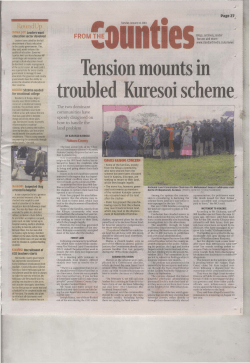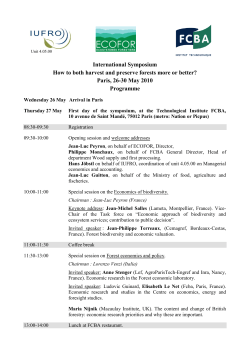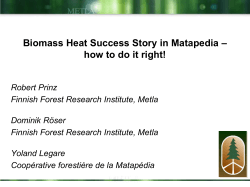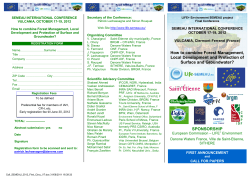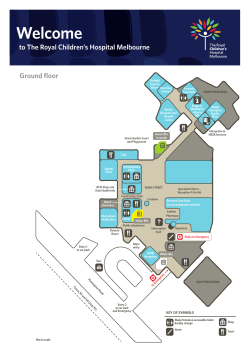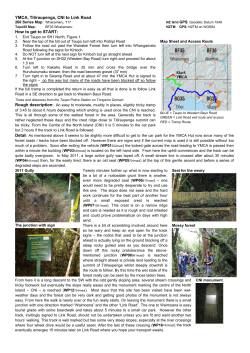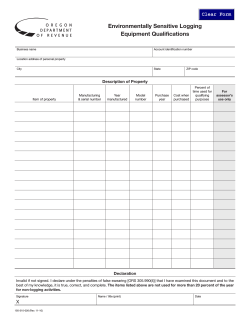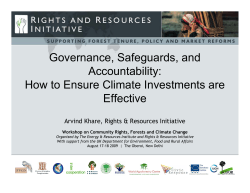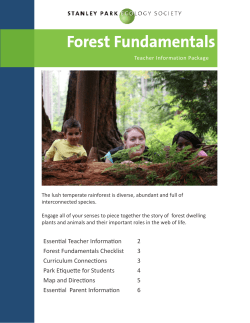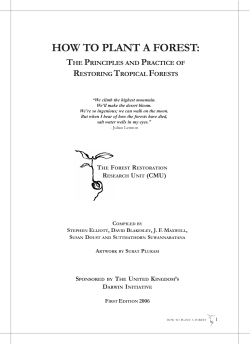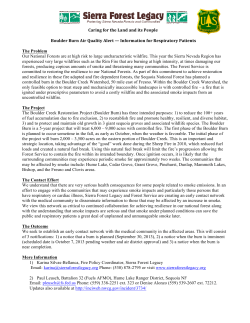
Research synopsis writing Introduction
Research synopsis writing by Helle O. Larsen (University of Copenhagen), modified by Davide Pettenella (University of Padova) Introduction This document provides guidelines for preparing a research synopsis (and indirectly of the final report of your work that will be presented at the end of your research program). The research synopsis is the plan for your research project. It provides the rationale for the research, the research objectives, the proposed methods for data collection and recording formats and/or questionnaires and interview guides. The synopsis is based on the information provided by the supervisor(s) and by secondary sources of information. In the final report you will present the results of your data collection and elaboration, with the discussion and the conclusion. The full synopsis should be maximum 3-4,000 words, excluding appendices. Standard headings 1. 2. 3. 4. 5. 6. 7. 8. 9. 10. 11. 12. 13. 14. Title* Abstract* Introduction* Problem analysis/literature review* Objectives* Hypotheses* Limitations* Methodology and methods* Results Discussion Conclusion References* Appendix A Research matrix* Appendix B Data collection instruments (e.g., interview guide, questionnaire)* Items marked by an asterisk are to be included in the synopsis, while items without asterisk are mentioned here only because they will be added in the final report of you research project. 1 Guidelines to the content of the sections Title This should be brief and self-explanatory. It should relate directly to the main objective of the proposed research. A more specific and descriptive sub-title can be added if necessary, for example to indicate the main methodology that will be applied. The title of the final report can be different from the working title of the synopsis. Box 1. Example of a title. The effect of participatory forest management on livelihoods: a case study from Tanzania. Based on a research synopsis prepared by Aklilu Ameha Yitagesu Abstract The abstract should briefly state the problem, the main objective(s), the theories/conceptual framework used (if relevant), and the method(s). The abstract alone should give the reader a clear idea about the research in no more than 150 words. Box 2. Abstract - example Tanzania’s protected areas contribute to the national income through protection of animal species and habitats attracting large numbers of tourists. But local communities who largely bear the costs of conservation receive only a small percentage of the benefit. Consequently, wildlife populations decline and habitats are being lost through conversion to agriculture. This study aims at estimating the total local economic value of conserving the Tarangire Ecosystem to contribute to an understanding of potentials for conservation through tourism. The contingent valuation method will be used to measure the willingness to pay and willingness to accept (dichotomous choice elicitation) of local communities for the protection of the Tarangire ecosystem. A two-stage systematic random sampling design will be used to select about 150 respondents to socioeconomic, perception and attitude, and contingent valuation surveys. Data will be analysed with logit/ probit models. Based on a research synopsis prepared by Yibeltal T. Wassie Introduction Here you should introduce the main problem, set it into context and introduce the particular niche within the main subject area that you will work with. For example, the main subject area could be deforestation and the Introduction would then briefly argue why it is relevant to be concerned with deforestation – to whom it is a problem and why. The niche could be the role of small-scale farmers in deforestation processes in mountain areas. Justification for the niche should also be included in the Introduction. 2 ‘Justifying’ a research problem means providing information documenting that both the main problem and the specific niche are of relevance to others than yourself, such as the scientific community and stakeholders. A research problem can be, for example, a gap of knowledge, an unexplained observation, something not yet analysed (using this systematic, with this level of detail, from this particular angle), or something that does not fit traditional beliefs (Rienecker and Jørgensen, 2006). The information you provide as documentation for the existence and relevance of the problem should primarily be scientific peer reviewed literature. Newspaper articles, blogs and a lot of material from the internet are not subject to quality control and are therefore considered less trustworthy. Box 3. Introduction - example An accurate estimate of forest productivity is one of the most fundamental requirements for forest managers and researchers planning forest management and research activities to attain the goal of near natural forest management. Site index models offer the managers and researchers a cost effective tool to determine the growth pattern of a particular species on a particular site. These models can be used to determine the forest product yield, to evaluate the alternative silvicultural systems and treatments on the basis of cost and benefit, to predict the structural changes in the stand for a relatively longer period of time (Vanclay, 1994). The usefulness of site index models are, therefore, not only limited to the academic or research domain of modern forestry, but can also be used as a readymade tool to estimate the site productivity (Vanclay, 1994; Nord -Larsen, 2006; Skovsgaard and Vanclay, 2008). Although application of forest models or site index functions dates backs more than a century, forest modelling approaches have not followed shifts in forest management objectives in global and Danish forestry. A review of the Danish forest management history reveals shifts in forest management objectives from sustained yield (1760s to 1980s) to sustainable multiple functions (after 1990s). Up till now most forest models have mainly been based on homogenous stands of commercial plantations and have aimed at estimation of productivity especially for commercial production of timbers. With the advent of the near natural forestry regime, forest management priorities and practices in Denmark have been redirected towards establishment of multifunctional heterogeneous forests. Therefore, new forest growth models are needed for forest management planning. New site index models that can address the structural variability of near natural forest management in Denmark are needed (Nord-Larsen, 2006; Skovsgaard and Vanclay, 2008). Based on research synopsis prepared by Bidya Nath Jha. Problem analysis/Literature review In this section you present details regarding the research problem. You should present documentation of the existence of the problem, how it is manifested, who it affects and involves, what roles and interests the involved actors have, the historical background to the problem (including what has lead to the actual situation), and the problem’s complexity (what it consists of and what it is a part of) (Dahl et al., 1999). The problem analysis is based on a critical review of scientific literature: the theories typically used to frame research on the subject area, knowledge available and research methods used with what degree of success. The review can add to the justification of choice of the subject included in the Introduction. It is important that the review includes recent literature, and that it critically synthesises knowledge within the subject being addressed rather than merely describing it. 3 A critical review of the subject being addressed involves (i) identification of relevant literature through a thorough and systematic literature search using combinations of relevant key words in appropriate databases, (ii) the relevant literature must be critically read, meaning that the soundness of research approach and conclusions must be evaluated – you should of course not base your arguments on untrustworthy literature, and (iii) important approaches, conclusions and/or discussions of the literature are presented in an argument logically leading to your objectives. Remember, the literature review is not just a list of the methods used/conclusions made by previous studies. Have a look at research papers published in international journals for inspiration – the introductions most often include highly condensed literature reviews. Objectives These should be identified on the basis of the problem analysis. That means, after reading the problem analysis it should be immediately clear that the choice of objectives is relevant and justified. The objectives should focus on concepts and problems mentioned in the problem analysis Each research proposal should contain one overall objective describing the general contribution that the research project makes to the subject area as well as one or more specific objectives focusing on discrete tasks that will be achieved during the research. The overall objective may be something that the study will contribute towards but not solve/finish; the overall objective should not be a compilation of the specific objectives. Box 4. Example of overall and specific objective. The purpose of the present study is to contribute to an understanding of the actual and potential roles vegetation plays in regulating the microclimate of urban settings in tropical countries. Specific objective are: 1. 2. 3. To quantify the magnitude of air temperature modification by urban vegetation of different spatial arrangement and density (crown cover/number of individuals per unit area) with emphasis to roadside plantings, gardens & urban parks in Dodoma, Tanzania To compare urban heat modification caused by vegetation consisting of single and mixed species, considering the five most common urban trees present in Dodoma, Tanzania. To assess the preferences of Dodoma’s inhabitants regarding tree species and planting patterns in relation to human thermal comfort. Based on research synopsis prepared by Gudina Legese Feyisa Hypotheses These are predictions of the outcomes from the study. It is useful at the outset to specify the hypotheses in terms of the assumed relations between variables so as to clarify the position and pre-understanding of the researcher. If statistical tests are to be conducted formulation of hypotheses is a crucial element of the research design. Hypotheses can be derived from theory, experience or knowledge concerning contextual factors. In purely quantitative, deductive research hypotheses are tested statistically, whereas in qualitative, 4 inductive research hypotheses are not formulated. In the Joint Summer Module you are unlikely to conduct purely qualitative research (although qualitative elements may be included), and so hypotheses are relevant. Limitations Although the specific or immediate objectives may be quite narrow, they could probably imply much more data collection and analysis than possible for a thesis. To demonstrate a good overview of the general subject area it should be specified what aspects will not be addressed and how this will limit conclusions. It is important to not (only) mention that due to time constraints a limited number of observations/measurements/interviews will be conducted. Rather, the aim here is on topical limitations. Methodological limitations can be put in the methods section. Box 5. Limitations – example. The overall objective of a research design was to explore the role of women in collection and distribution of forest foods. The limitations of the study were: This study will focus on amounts and species of forest foods collected by individual households. Details on the nutritional content of the individual foods will not be included and thus conclusions on the contribution of forest foods to micronutrient or calorie intake are not possible. Based on a masters thesis prepared by Marie Staun. Methodology and methods A research project follows an overall methodology to make conclusions in relation to the overall objective. Some types are experiments, surveys, models and case studies. Within a given research methodology several data collection methods can be relevant, and both quantitative and qualitative methods may be used in the same study. You should specify what research methodology is chosen to fulfil the research objectives (see Appendix A). A description of the methodology used does not mean a reproduction of standard textbook definitions, in stead, references should be used. For example, it is not necessary to explain that a case study approach ‘will allow in-depth analysis of a particular problem and that the limitation is that the results cannot be statistically generalized, but that they could be theoretically generalized for places with similar characteristics’. This is part of the definition of a case study (Yin, 2006), and it would be more informative to explain why a case study approach is suitable in the specific context. Likewise, there is no need to describe in general terms what data will result from an inventory or a semi-structured interview. A reference will be sufficient for commonly used methods, whereas it is relevant to describe the specific data to be collected. The description of data collection methods should always be as specific and realistic as possible. It should be clear that the chosen methods are appropriate and suitable for achieving the objective. A useful step in that regard is to identify what data is required to answer the specific objectives/research questions (Appendix A). After having read the section on methods, the reader should have a clear understanding of what will be actually 5 done during data collection. State what data will be collected using a given method and avoid vague or general statements. An important part of the methods description is the sampling design. How, and how many, objects for experiments, plots for a vegetation survey, or respondents to questionnaires/interviews are chosen have implications for the subsequent possibilities for generalisations and the validity and reliability of research findings. An often overlooked part of student research design is the data analysis. However, if data analysis is not considered before collection important data are likely to be missing at the write-up stage. You should, as a minimum, have an idea of what calculations and combinations of the data you will make. The research synopsis must specify how the collected data will be analysed to answer the research questions/objectives Strategies may include testing of hypotheses, which means that dependent and independent parameters for analysis should be clear as should the type of statistical analysis, the number of observations needed etc. A qualitative analysis of, for example, people’s response to a specific change could require analysis of the meaning of responses and/or behaviour observed, possibly guided by theory. To recapitulate: it is important to envision how all the information collected will be combined to provide a meaningful answer to the research objective. Results This section presents the analysed data, preferably in tables and charts. It is a good idea to organise the results logically, for example by first presenting background information like demographics and then continue with in a sequence reflecting the specific objectives. All tables and figure must be numbered and referred to in the text. Table headings go above the table, figure headings go below the figure. Traditionally, you do not discuss the results in this section. That means, you do not explain why a specific number is an outlier, or why few people answered a specific question – you leave to the Discussion. Discussion Here you discuss what the results mean in relation to the objectives. You also discuss the influence of the chosen methods on the results and what methodological problems may have been faced. Finally, you compare your own results with those of other studies to identify whether your study is in accordance or at odds with previous scientific studies. If the latter is the case this warrants special consideration. Conclusion Start by clearly stating the main finding of the research. Then go on to outline the implications of the findings. How important is your contribution to the understanding that is currently held on the subject area and niche? What future studies could be recommended (don’t overdo the last point). 6 References When you cite literature there are standards to be followed for in-text citations and the format of the reference list. You should use the Harvard referencing system, meaning that in-text citations consist of author name(s) and publication year, for example: Swanson, 2005. Literature can be used passively, in which case the author name(s) and publication year are put in brackets: The moon is made from cheese (Silverbrandt, 1935). When the author name is used actively only the publication year is put in brackets: Silverbrandt (1935) argued that the moon is made from cheese. When an article is written by two authors the in-text citation is (Oldfield and Morse, 2009) or (Oldfield & Morse, 2007). The coma before publication year can be omitted – but then it should always be omitted. A very crucial point is to decide which of several possible formats to use and then to follow it consistently. The purpose of a reference list is that the reader should be able to find the references used. Therefore, be sure to write the full reference in the reference list, including author, publication year, title, title of journal/series, volume of journal/series contribution, publisher (omitted for journal), location (omitted for journal), page numbers. For chapters in books and contributions to conference proceedings the editors and title of the book/proceedings must be added. You can choose a standard from, e.g., a scientific journal and follow it consistently. All references in the text must be in the list of references and vice versa. Appendix A Research matrix A logical visual representation of the research design helps to ensure coherence - use the research matrix template provided below while developing the design. Submit the final version with the synopsis. Appendix B Data collection instruments The translation of a good research design into good results requires thorough preparation of data collection. For measurement and observation this means preparation of data entry forms, while for surveys and interviews questionnaires and interview guides are necessary. Include the data collection instruments for each method you plan to apply. References Dahl, A., Dich, T., Hansen, T., Olsen, V. 1999. Strenghten project work: A toolbook for problem-based project work. [Styrk projektarbejdet: En redskabsbog til problemorienteret projektarbejde]. Biofolia, Frederiksberg. Rienecker, L. and Jørgensen, P.S. 2006. The good assignment. [Den gode opgave]. 3rd edition. Forlaget Samfundslitteratur, Frederiksberg. Yin, R.K. 2003. Case study research: design and methods. Applied Social Research Methods Series 5. Sage, Thousand Oaks. 7
© Copyright 2025


